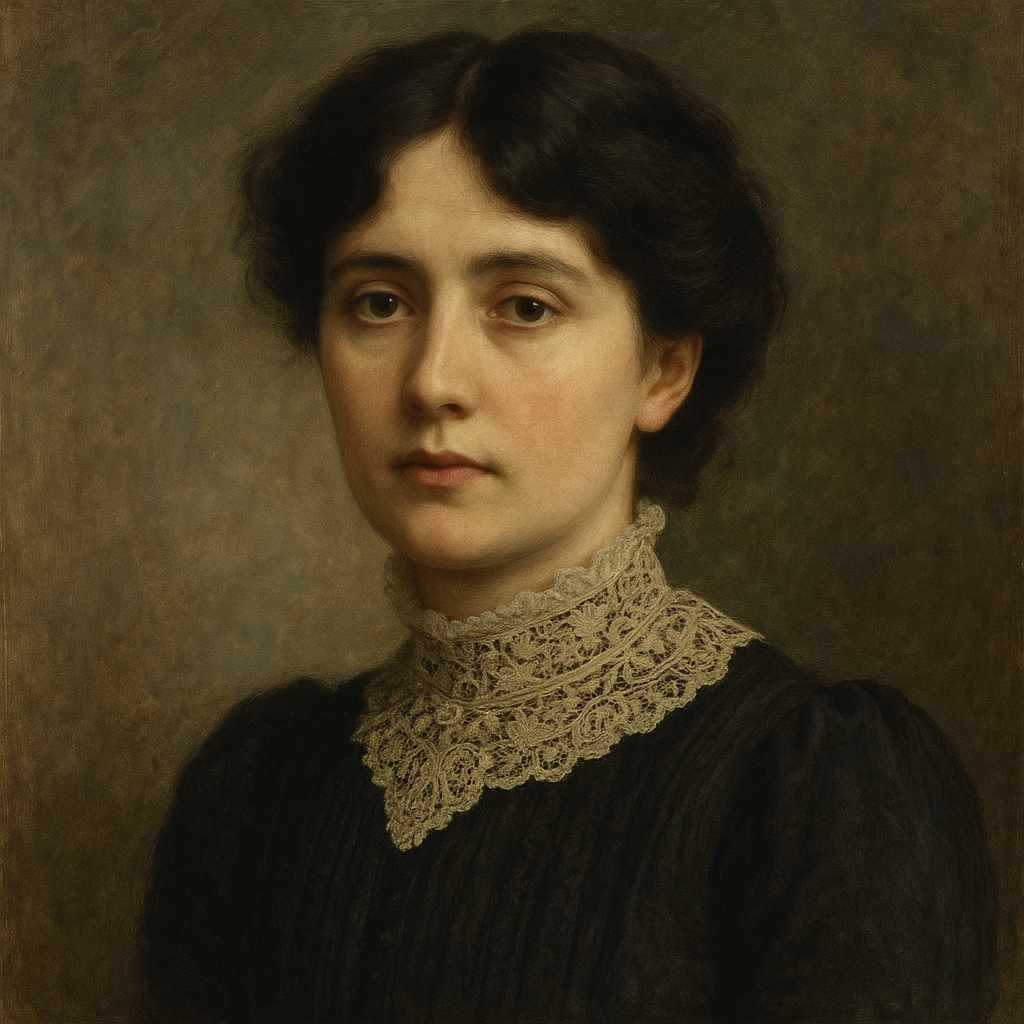The World's Desire
Nora Hopper Chesson
1871 to 1906

There was born to the world last night
A woman-child for the world's delight.
Her mouth was small as a rosebud is
Before the bee and the blossom kiss;
Her hair was a cloud and her eyes were fire.
Her hands were full of delight and desire.
Her cheek was a rose full blossoming.
Her voice was honey, her tongue a sting.
Before the night took thought of the day
The child was born — with a caul, they say.
The caul shall serve her in place of a charm,
That water and fire shall not do her harm.
The child was born to bring all men grief.
Hunger and thirsting beyond relief.
An ill star shone on the bitter morn
When the mother died and the child was bom.
She shall be christened with water of tears.
With doubtful pleasure and trembling fears;
We will name her Helen, that she shall be
A warning, a wonder 'twixt sea and sea.
Though the waves o'erwhelm her, she shall not drown.
She shall not burn in the burning town:
Except she burn of her own white fire.
The world's disaster, the world's desire.
Nora Hopper Chesson's The World's Desire
Nora Hopper Chesson’s The World’s Desire is a haunting and evocative poem that explores themes of beauty, destruction, and fate through the lens of myth and prophecy. The poem’s subject—a newborn girl destined to be both "the world’s disaster" and "the world’s desire"—immediately evokes classical archetypes, particularly the figure of Helen of Troy, whose legendary beauty brought about war and ruin. Chesson’s work, though brief, is densely packed with symbolic imagery, paradox, and a sense of foreboding that invites deep literary and philosophical analysis. This essay will examine the poem’s historical and cultural context, its use of literary devices, its thematic concerns, and its emotional resonance, ultimately arguing that Chesson crafts a meditation on the dual nature of desire—its capacity to enchant and to destroy.
Historical and Cultural Context
Nora Hopper Chesson (1871–1906) was an Irish poet and writer associated with the Celtic Revival, a movement that sought to reclaim and celebrate Ireland’s mythological and folkloric heritage. Her work often engaged with themes of fate, enchantment, and the supernatural, reflecting both her Irish roots and broader fin-de-siècle literary preoccupations with beauty and decadence. The World’s Desire was published in 1896, a period when poets like W.B. Yeats and Arthur Symons were similarly exploring mythic femininity—figures like Helen, Deirdre, and the Sidhe—as symbols of both transcendent beauty and inevitable tragedy.
The poem’s explicit invocation of Helen of Troy situates it within a long tradition of Western literature that grapples with the destructive power of beauty. From Homer’s Iliad to Christopher Marlowe’s Doctor Faustus ("Was this the face that launched a thousand ships?"), Helen has been a cipher for the paradox of desire: she is both an object of adoration and a harbinger of catastrophe. Chesson’s poem aligns with this tradition while infusing it with a distinctly late-Victorian sensibility—one that blends Celtic mysticism with a fascination for doomed femininity.
Literary Devices and Symbolism
Chesson employs a rich array of literary devices to convey the poem’s central paradox—the coexistence of beauty and destruction in the figure of the newborn girl. The imagery is lush yet ominous, with each line layering sensory detail with prophetic weight.
1. Paradox and Oxymoron
The poem thrives on contradiction, presenting the child as both a source of "delight and desire" and an inevitable bringer of "grief." This duality is encapsulated in the final line, where she is called "the world’s disaster, the world’s desire." The oxymoronic tension between these two states suggests that desire itself is inherently destructive—that what is most beautiful is also most perilous.
2. Mythic and Folkloric Symbolism
The reference to the child being born "with a caul" (a membrane covering the head at birth, often considered an omen of supernatural protection) ties her to folkloric traditions where such children are marked by fate. The caul, serving as a charm against drowning and burning, suggests that she is destined for a grand, tragic fate—one that cannot be escaped by ordinary means. This detail aligns with the myth of Helen, who was said to be the daughter of Zeus and thus semi-divine, protected by her lineage yet fated to bring ruin.
3. Sensory Imagery
Chesson’s language is intensely sensory, evoking sight, touch, and sound to create an almost hypnotic portrait of the child:
-
"Her mouth was small as a rosebud is / Before the bee and the blossom kiss" – The simile suggests both innocence and latent danger (the bee’s sting foreshadowing the "sting" of her tongue).
-
"Her hair was a cloud and her eyes were fire" – The juxtaposition of softness (cloud) and danger (fire) reinforces her dual nature.
-
"Her voice was honey, her tongue a sting" – The contrast between sweetness and pain encapsulates the poem’s central tension.
4. Foreshadowing and Prophecy
The poem functions as a kind of oracle, foretelling the child’s future with grim certainty:
-
"The child was born to bring all men grief. / Hunger and thirsting beyond relief."
-
"She shall be christened with water of tears."
These lines suggest that her very existence will be a curse, evoking the idea of an inescapable fate—a theme resonant in both Greek tragedy and Celtic legend.
Themes and Philosophical Underpinnings
1. The Destructive Power of Beauty
The poem’s most explicit theme is the idea that beauty is inextricably linked to suffering. The child, though enchanting, is a harbinger of "hunger and thirsting beyond relief," suggesting that desire—once awakened—can never be fully satisfied. This aligns with Arthur Schopenhauer’s philosophical view that desire is the root of suffering, as well as with the Decadent movement’s preoccupation with beauty as a destructive force.
2. Fate and Free Will
The child’s destiny appears preordained: she is named Helen before she can choose her own identity, and her fate is sealed by the "ill star" under which she was born. This fatalism echoes Greek tragedy, where characters are often powerless against the whims of the gods. Yet there is a suggestion that her destruction will come from within—"Except she burn of her own white fire"—implying that desire is not merely imposed upon her but is an intrinsic part of her being.
3. Feminine Archetypes and Agency
The poem engages with the trope of the femme fatale, a figure whose allure leads men to ruin. Yet Chesson’s portrayal is ambiguous: is the child truly a malevolent force, or is she merely a vessel for the world’s own destructive desires? The poem does not grant her interiority—she is described only through her effects on others—raising questions about agency and blame. Is she the architect of disaster, or merely its symbol?
Emotional Impact and Contemporary Relevance
Despite its mythic framing, The World’s Desire resonates on a deeply human level. Its portrayal of beauty as both a blessing and a curse speaks to timeless anxieties about love, longing, and loss. The poem’s prophetic tone lends it a tragic grandeur, while its sensory richness makes its central figure vividly compelling.
In a modern context, the poem invites reflection on how society projects both adoration and blame onto women who embody desire. The figure of Helen—whether in ancient myth or contemporary celebrity culture—remains a locus for cultural anxieties about femininity, power, and destruction. Chesson’s poem, though written over a century ago, feels strikingly relevant in an age where women in the public eye are still often idealized and vilified in equal measure.
Conclusion
The World’s Desire is a masterful exploration of the paradoxes of beauty, fate, and femininity. Through its rich symbolism, prophetic voice, and interplay of enchantment and doom, Chesson crafts a poem that is both timeless and deeply rooted in its late-Victorian context. By invoking Helen of Troy, she taps into a mythic tradition that stretches from Homer to Yeats, while infusing it with her own distinctive blend of Celtic mysticism and Decadent sensibility. The poem’s power lies in its ability to evoke both wonder and dread—to remind us that desire, in all its splendor, carries within it the seeds of its own undoing.
In the end, Chesson does not offer resolution but instead leaves us with an unsettling truth: the things we most desire may also be the things that destroy us. And perhaps that is the most enduring and universal tragedy of all.
This text was generated by AI and is for reference only. Learn more
Want to join the discussion? Reopen or create a unique username to comment. No personal details required!



Comments
No comments yet. Be the first to comment!